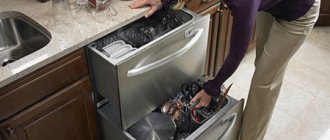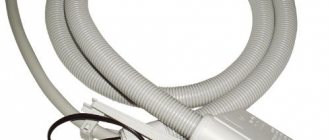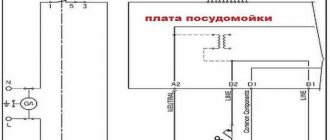Correct installation of the dishwasher is the key to further trouble-free operation of the device. When installing a built-in model under a hob, it is necessary to ensure safe operating conditions for nearby household appliances for various purposes. They are heated by combustion, induction or electricity - for stoves of each type of energy, their own installation standards are recommended.
- Reasons for limiting installation under the slab
- Placing the dishwasher under the hob
- Recommendations for installing adjacent devices
- Catalog of dishwashers with reviews
Memo for a dishwasher installer
For those who decide to install a dishwasher themselves, there are several rules that, if followed, will allow you to correctly install the dishwasher and also extend its service life:
- Gas technicians check stoves every year, which requires them to move the stove, and with it the dishwasher installed under the hob.
- The height of the legs of the lower cabinet should not be less than 15 centimeters. This distance is necessary for running the gas cord.
- A special gasket should be placed between the top edge of the dishwasher and the stove to protect it from moisture and high temperatures.
- The height of the hob should not exceed 4 centimeters. This is necessary so that it fits completely into the cut hole.
- Do not forget that placing a dishwasher under the stove is extremely risky. It is worth approaching this issue with utmost care.
Is it possible to place a dishwasher next to the stove: an oven, in a pencil case under the oven
Each manufacturer indicates in its instructions specific rules for placing this model of dishwasher in the kitchen. The main requirement of manufacturers is that it is inadmissible to install a dishwashing machine next to other objects. It is important for the owner of household appliances to organize the creation of an air gap around the dishwasher.
Advice! The technological gap space (at least 40 cm) can be used to create an additional compartment inside the built-in kitchen (for example, for a bottle holder or storage box).
Another recommendation from manufacturers is to fix the machine evenly on both sides. This can be ensured by adjacent drawers in the built-in kitchen, which have a rigid fastening.
Selecting a location
Some people prefer to install it on the edge, others mount the equipment right in the middle, near the stove or built-in washing machine.
It is important that it is located as comfortably as possible for use, but does not create additional discomfort in the kitchen.
When ordering kitchen furniture, it is better to foresee the subsequent installation of household appliances in advance.
Regarding choosing a suitable location, you can give several recommendations:
Rules for combining a dishwasher with household appliances in the kitchen
Let's take a closer look at which place can be considered the most suitable for a dishwasher.
Is it possible to place a dishwasher next to a stove, hob or oven?
The main question that worries dishwasher owners is whether it is permissible to place household cooking appliances (oven, hob, gas or electric stove) and a dishwasher nearby. Recommendations for installing a stove, oven, hob and dishwasher:
- It is necessary to ensure that a technological gap of 40 cm is maintained between the side walls of the dishwasher and the stove or oven.
- It is unacceptable to place the hob directly above the dishwasher.
Violation of the rules will lead to the fact that, under the influence of high temperatures, the sealing machine of the device will dry out and cease to provide a tight seal.
Dishwasher installation conditions
Before purchasing and installing a dishwasher, you need to find a suitable place for it.
The easiest way is with free-standing units - even a piece of free space on the floor or table is enough for them. But what to do when you plan to buy a built-in model that can be hidden behind a decorative panel?
You need to arm yourself with a construction tape and check which cabinets are suitable for installing a PMM. Finding out the sizes of dishwashers is easy - information is posted on the official websites of stores that sell household appliances.
When making machines, manufacturers are guided by human height and furniture sizes, and accordingly adapt their models to uniform standards.
Source: https://doma-iz-brusa-36.ru/kvartira/posudomojka-v-uglu-kuhni.html
Stove next to refrigerator
The stove is the most dangerous neighbor for a refrigerator, especially if it is gas. Ideally, these two antipodes should be placed as far apart as possible. For this, in addition to the main reason (harmful heat), there are a couple of arguments against:
- The refrigerator gets dirty intensively due to splashes of fat during cooking;
- If the stove is located next to the refrigerator, then frying pans with handles and large pots will not fit on the burners closest to it.
What distance should be between the stove and the refrigerator? It is best to learn these standards from the instructions for a specific refrigerator model, since the recommendations of different manufacturers differ slightly. For example:
- Bosch allows you to place the refrigerator next to a gas stove at a distance of 30 cm, and next to an electric stove or hob - at a distance of at least 3 cm.
- Zanussi recommends placing the refrigerator next to the gas stove at a distance of at least 50 cm. Electric stoves and hobs can be placed at a distance of 5 cm.
The recommended option for the coexistence of a refrigerator and stove is shown in the photo below.
Built-in refrigerator next to the gas stove at a distance of 40 cm
But, as practice shows, in very small kitchens, for example, in Khrushchev-era apartments, it is difficult or even impossible to maintain the correct gaps. Therefore, many homeowners place the stove and refrigerator close to each other. Here are some photo examples of such kitchens.
Refrigerator next to gas stove and oven
Refrigerator next to a gas stove in the interior of a small kitchen in Khrushchev
Built-in refrigerator next to a gas mini-stove in the interior of a redesigned kitchen-living room in Khrushchev
Refrigerator next to the hob
So, what to do if the kitchen is very small and creating even a 3-centimeter gap seems impossible? We offer the following 6 solutions that will help solve the problem as a whole or on their own:
- Stick a thermal insulation material, for example, Fomisol or Izolon PPE, on the wall of the refrigerator. This method is the simplest, most cost-effective and at the same time effective - the refrigerator can even coexist with a gas stove. All you need to do is: cut the material and carefully glue it (preferably the material is self-adhesive). An important nuance: the upper part of the refrigerator wall will continue to heat up a little, since heat tends to rise upward. But this problem can be easily solved if you always use a hood (read about it below).
Example of thermal insulation of a refrigerator next to the stove
- Use a powerful hood. It captures most of the convective flows from the stove and thereby significantly reduces the heating of the refrigerator.
- Build the refrigerator into the box. So the frame of the box will act as a barrier and take the “thermal shock” upon itself. In addition, it will protect the refrigerator body from splashes of grease and dirt. For best results, it is still worth gluing a layer of thermal insulation on the refrigerator.
- Place a partition or screen between the refrigerator and the stove. The benefits of this method are still the same - protection from dirt and the creation of a barrier from heat. What can a screen or partition be made from? MDF panels, plywood, plasterboard, tempered glass (in combination with thermal insulation) are suitable. Here are a couple of photo examples.
- Replace full-size appliances and sinks with smaller versions. This will allow you to gain precious centimeters and place the refrigerator and stove not end to end. Here's what you can do:
Replace the standard stove with a mini-stove with two burners. This way you can increase the distance between the refrigerator and the stove to 15-25 centimeters. As practice shows, two burners are 100% enough for an average family of 4 people.
- Place a narrow refrigerator (up to 55 cm wide). Even a couple of freed centimeters will improve the situation.
- Choose a small sink. Yes, it is not very convenient, but it is quite viable, especially if you have a dishwasher. By the way, sometimes you can create a small distance between the stove and the refrigerator by moving the sink.
- In the end, the refrigerator can be moved into the hallway or adjacent living room.
Ready solution
Manufacturers of household appliances came to the aid of those wishing to place appliances in this way and released a model that combines a hob, oven and dishwasher. The multifunctional miracle appliance has 4 gas burners, a small oven, and a small dishwasher. The advantages of such a device:
economical consumption of water and energy resources;
combination of different types of kitchen appliances in one design;
the price of the device does not exceed the total cost of three household appliances.
There are also disadvantages:
the small size of the oven has only one sheet, so it will not allow you to cook a number of dishes, forces you to bake in several batches and is not suitable for a large family;
The modest size of the dishwasher makes it possible to wash the same amount of dishes, so again, for a large family this is not the best option.
Thus, this interesting kitchen unit will be an excellent solution for a small family or a bachelor. The device will save space and will not cause any installation difficulties. It is enough to provide measurements of the multifunctional appliance to the kitchen designer for optimal placement.
If you like to cook a lot or your family has more than four people, this device will not be the best choice; it is worth considering combining separate devices.
To learn how to avoid mistakes when installing a dishwasher under the hob, watch the video below.
Limited space in the kitchen is a sore point for Russians and residents of countries where houses built by Khrushchev are used. Any resident of a “separate apartment” in such a house will tell you a bunch of stories about who built these houses and with what hands. But that’s not what we’re talking about now. We need to solve a very specific problem, namely, to ensure that the hob above the dishwasher is placed as well as possible, so that these two appliances do not have a negative impact on each other and do not fail. This is what we will do.
Expert opinion on the issue
Installing a dishwasher under the hob is not the easiest task. The installation process mainly depends on the type of slab.
The main disadvantage of installing a dishwasher under a gas stove is that during operation the latter will heat up and transfer heat to the built-in unit, which can negatively affect its operation.
Incorrect calculation of distance can also be a big problem. If you install the machine on a table, a steamer is included in the design to protect it. When installing the device under a gas stove, problems may arise with steam removal. Due to an incorrectly calculated distance, steam can damage equipment.
Table top height
Not only the possibility of installing a dishwasher under the hob, but also the ease of use of the equipment depends on it. The standard height from floor level to the top of the tabletop takes into account the average height of a person (160-180) and ranges from 88 to 91 cm.
| Height | Recommended height |
| 150 cm | 76-82 cm |
| 160-180 cm | 88-91 cm |
| more than 180 cm | about a meter |
The height of the countertop under the cooking platform is determined differently - focus on the tallest pan, which will be convenient to look into when cooking on the stove. For average height, a height of 80-82 cm is usually enough.
How to install a dishwasher: choosing a location
Before you begin installing the dishwasher, you need to determine the location in which it will be located. It is worth considering several important points. The easiest way is to choose a place for models that are integrated into the kitchen set. Such devices are most often mounted in furniture modules, which belong to the first level (floor cabinets). An area with a small amount of space should be allocated for the dishwasher.
Compact models, if desired, can be built in a place that is most convenient to reach. They can be placed at chest level in a furniture set. Errors when choosing the location of the PMM often lead to difficulties with operation and maintenance, so first of all it is necessary to build on the type of dishwasher and the features of a particular device. This will allow you to integrate it into the kitchen ensemble as harmoniously as possible.
The most suitable place to install a dishwasher is the module located next to the sink. This is quite logical, since all the water supply and sewerage units that are necessary to connect the PMM are concentrated in this area. By choosing this location, there will be no problems connecting hoses to all necessary communications.
The module located next to the sink is considered the most suitable place to install a dishwasher
Models from foreign manufacturers (for example, Electrolux) are best suited for quick installation. Installing a dishwasher is often accompanied by a variety of minor setbacks. Problems arise much more often if you need to choose a place for a dishwasher in a finished set. In such a situation, there is only one thing left to do - adjust the dimensions of the furniture to the dimensions of the device. If this fails, then you will have to dismantle individual modules of the kitchen ensemble.
Thus, the most important rule is to select in advance a suitable place in which the dishwasher will be placed. This rule applies not only to dishwashers, but also to other kitchen appliances.
The sketch of the kitchen set should be drawn up second.
Hob and oven
5. The hob can be built in anywhere
A typical question from a buyer of a new kitchen set: “Which cabinet will we build the cooker into?” Anytime. The hob is built only into the countertop, and it doesn’t matter what is underneath it - a hinged door, a drawer, or nothing at all. In this case, it is not at all necessary that the oven be located immediately under the cooking zone. Yes, this is the most popular zoning option, but only because in average small kitchens there is simply nowhere else to put the oven, or there is only one specific place left for cooking.
A certain exception is the gas hob - its special design, connection and air exchange really require a small space under the countertop. In all other cases, the cooker can be installed either in an island or in a remote bar countertop.
6. You can place the oven next to the refrigerator
We were all taught that “hot” and “cold” are not allowed – it’s a fire hazard. Indeed, if you have the good old “Dream” in your kitchen, then its heat is quite capable of damaging the refrigerator. But modern built-in ovens are equipped with a powerful ventilation system. Thanks to it, not only the refrigerator standing next to it, but even the body of the cabinet in which the oven is located does not heat up. And in general.
The only caveat is that you need to open the oven carefully, stepping aside, because all the heat will come out through the door.
Article on the topic: What was the name of the first dishwasher Candy
7. An oven at eye level is cool
The trend in modern kitchens is to move the oven into a separate cabinet at chest level. It's incredibly convenient. With such zoning, you no longer need to jump on your haunches, trying to get chicken or cake out of the oven, or bend over to watch the cooking process. What can we say about the ease of cleaning the oven.
Recommendations for installing adjacent devices
Dishwashers can be combined with different types of hobs. Installation features can be specific or general. In the second case, adhere to the following recommendations:
leave a gap between the dishwasher and the stove, fill it with heat-water-insulating material;
place the structure made of PMM and the stove near the sink: it is convenient to wash off any leftover food before placing the dishes in the washing chamber;
mount the machine in the gap between two sections of furniture, and build the stove into the countertop.
To reduce the mutual negative influence of devices, it is better to turn them on at different times. This approach allows you to increase the service life of both devices: the PMM and the hob.
It is possible to place a dishwasher under an overhead stove, but with reservations. If there are no other placement methods, installation in a column is allowed. When the family budget allows, it is better to buy a combined washing-cooking unit.
What types of dishwashers are there?
Manufacturers try to satisfy any consumer needs, so they produce different types of dishwashers:
- Stationary devices. These are free-standing machines that can be placed on the floor if they are full-size, or on a table if they are compact. They do not need fixation, they are self-sufficient. They can be moved from place to place. The main thing is to provide them with water and electricity.
- Built-in. Such machines can be installed in kitchen cabinets, under sinks, and countertops. They can be fully or partially built-in.
Expert opinion on the issue
Installing a dishwasher under the hob is not the easiest task. The installation process mainly depends on the type of slab.
The main disadvantage of installing a dishwasher under a gas stove is that during operation the latter will heat up and transfer heat to the built-in unit, which can negatively affect its operation.
Incorrect calculation of distance can also be a big problem. If you install the machine on a table, a steamer is included in the design to protect it. When installing the device under a gas stove, problems may arise with steam removal. Due to an incorrectly calculated distance, steam can damage equipment.
Memo for a dishwasher installer
For those who decide to install a dishwasher themselves, there are several rules that, if followed, will allow you to correctly install the dishwasher and also extend its service life:
- Gas technicians check stoves every year, which requires them to move the stove, and with it the dishwasher installed under the hob.
- The height of the legs of the lower cabinet should not be less than 15 centimeters. This distance is necessary for running the gas cord.
- A special gasket should be placed between the top edge of the dishwasher and the stove to protect it from moisture and high temperatures.
- The height of the hob should not exceed 4 centimeters. This is necessary so that it fits completely into the cut hole.
- Do not forget that placing a dishwasher under the stove is extremely risky. It is worth approaching this issue with utmost care.
The perfect solution
Saving kitchen space is a fad for many people. How to optimally use the footage, fitting everything you need in a small kitchen is a question that many homes are trying to solve. Manufacturers of household appliances are trying to take this factor into account in their new models. This is how Candy tried to solve the problems that arise when installing a dishwasher under a hob.
An installed cabinet creates serious difficulties during its operation, so stove developers have released a number of models that already have a dishwasher, thereby saving their customers from unnecessary hassle. This model is called combined due to the following positions:
- Availability of 4 gas burners.
- Electric oven with grill available.
- Availability of a built-in dishwasher.
Knowledge about the advantages and disadvantages of the model will help you make a decision to purchase such a “kitchen monster”. Pros:
- Serious space saving.
- Ease of use.
- The quality of every element.
- High technology of the device.
- Saving not only space, but also indicators on water and electricity meters.
The disadvantages include:
- Possible difficulties during connection.
- Due to the fact that the model is new, not all weaknesses in the design may be taken into account, which can lead to breakdowns.
- Small volumes.
- Installed only if there is a tiled or metal apron.
Overview of suitable models
To install under the hob, it is better to choose a built-in model - full-size, narrow or compact.
Weissgauff BDW 6083 D
Large machine with display and electronic control. Consumes 0.93 kW/h per cycle. Noise at 49 dB. Drying type: condensation. There is a clean water sensor. Delayed start timer - up to 24 hours. The use of tablets is provided. There is a beam indicator on the floor. Specifications:
| Type | full size |
| Installation | fully built-in |
| Capacity, sets | 14 |
| Energy consumption | A++ |
| Washing/drying | A/A |
| Water consumption per cycle, l | 10 |
| Dimensions (WxDxH), cm | 59.8x55x81.5 |
| Programs, pcs. | 8 |
| Approximate cost, rubles | 20 000 |
The advantages that the owners of the model wrote about in their reviews:
- high-quality washing;
- there is a backlight;
- roomy;
- works quietly;
- affordable price;
- stylish design;
- basket height adjustment;
- many useful programs;
- there is soaking;
- high energy consumption class.
Users did not mention any shortcomings - they simply did not identify them during the operation of the device. You can trust the quality of this machine - inexpensive but reliable equipment.
Indesit DISR 16B - narrow
One of the most popular PMMs. Consumers deservedly appreciated the combination of affordable price, quality and functionality. A standard wash lasts 180 minutes. Energy consumption - 0.83 kW/h. The model is somewhat noisy - 51 dB. Condensation drying type. A full range of programs - there are standard and special ones. Partially protected from leaks. Weighs 31.5 kg. Specifications:
| Type | narrow |
| Installation | fully built-in |
| Capacity, sets | 10 |
| Energy consumption | A |
| Washing/drying | A/A |
| Water consumption per cycle, l | 10 |
| Dimensions (WxDxH), cm | 44x55x82 |
| Programs, pcs. | 6 |
| Approximate cost, rubles | 16 000 |
A budget model in which users, in addition to the moderate cost, noted the following advantages:
- simple controls;
- moderate noise;
- roomy;
- high-quality assembly;
- many useful programs.
Minuses:
- the use of “3 in 1” tablets is not provided;
- not very high-quality washing in ECO mode;
- lack of display;
- no half load.
Flavia CI 55 HAVANA - compact
This small machine is quite suitable for being built under the hob. It is electronically controlled and equipped with a display. The water heater is instantaneous. Consumes 0.61 kW/h per cycle. Noise - 52 dB. Partial protection against leaks. You can use three-in-one tablets. A one-hour program is provided. Technical specifications:
| Type | compact |
| Installation | fully built-in |
| Capacity, sets | 6 |
| Energy consumption | A+ |
| Washing/drying | A/A |
| Water consumption per cycle, l | 7 |
| Dimensions (WxDxH), cm | 55x50x43.8 |
| Programs, pcs. | 7 |
| Approximate cost, rubles | 16 000 |
Advantages noted by owners of the compact machine:
- affordable price;
- compactness plus built-in - ideal solution for a small kitchen;
- works quietly.
Disadvantages and recorded breakdowns:
- two years later the control module broke down - this is almost half the cost of the device;
- after a year and a half of operation, the rinse aid does not supply;
- does not respond to the delayed start button and program selection;
- Economy mode lasts too long - 215 minutes;
- if the powder is cheap, it does not wash dishes;
- Doesn't clean the inside of mugs well.
Candy Trio 9501
Three in one. Having purchased such a device, you don’t have to worry about installing a dishwasher under the stove. This universal technology already contains everything:
- gas 4-burner stove;
- electric oven with grill;
- dishwasher with a capacity of 6 sets.
The volume of the PMM chamber corresponds to the capabilities of compact dishwashers. This type of machine is enough for a small family; you can’t fit a lot of pots and pans here. There are 5 programs. Water consumption per cycle is 9 liters. Approximate cost: 76,000 rubles.
Housing Installation
Having completed the work of connecting the dishwasher to the electrical network, you can move on to solving another problem - leveling. To do this, select the optimal height of the legs. There is no need to rush to immediately integrate a dishwasher into your furniture set. Before doing this, be sure to test run the empty machine, first filling the dish container with detergent. To avoid any problems when installing a dishwasher, be sure to consider the following nuances:
It is advisable to cover the inner surface of the furniture in which the dishwasher will be built with a vapor barrier to increase its service life. If you are going to install the machine not on the floor, but on a headset base, then find out whether it can handle such a load, and take care to install the device strictly level. It is not advisable to install a dishwasher box next to a hob or electric oven. When adjusting the height of the dishwasher, make sure that its upper part coincides with the level of the countertop.
At the final stage of installing a dishwasher in the kitchen, you must do everything necessary to ensure that it is hidden from the eyes of others. To do this, a decorative facade is installed on the side of the car door. Most modern built-in dishwashers are supplied with special templates that simplify the procedure for fastening the facade. The fasteners are screwed into the grooves located on the body of the dishwasher, after which the decorative panel or door itself is installed.
Installation Basics
Depending on the type of dishwasher, methods and recommendations for installing it may vary, but there are several things that are important to follow for any model:
- It is best to install the dishwasher between two sections. This is necessary in order to secure the equipment better. Installation in the corner of the kitchen will not give this result, and the machine may become loose during operation, which will reduce its service life.
- It is recommended to place the dishwasher close to the sink. This is due to the fact that dirty dishes need to be cleaned of any remaining food before they are put into the machine. And it will be much easier to get detergents, which are usually located in the sink area.
- Another “convenient” rule has become to place washing equipment next to dish drawers. Thanks to this installation, you don’t have to reach far to put clean dishes back in place.
How to calculate the width of the facade
In order for the product to look neat and attractive, the dimensions of the facade should be slightly larger than the dimensions of the equipment. But on sale there are panels of standard sizes with a width of 45 to 60 cm and a height of up to 82. Therefore, before you start purchasing, measure the unit you have at home, and, based on its parameters, choose the panels required in size.
Since the facade itself is an independent product, it will be almost impossible to adjust it at home, since the design feature and integrity of the decorative element will be compromised.
But what are the sizes of built-in 45 cm dishwashers and how they are installed is described in detail
The dimensions of the facade will completely depend on the parameters of the cabinet, but here it is necessary to add a few centimeters for fastening to the cabinet doors.
And if the size of the machine is approximately 44.5 cm, then the side of the facade must be at least 46 cm.
The same approach should be used for equipment with a side of 60 cm - 1-2 cm more, so that it is convenient to open/close the doors for turning on and loading dishes into the equipment.
The video shows the calculations:
When decorating a kitchen, you should pay attention to what types of
Rules for combining a dishwasher with household appliances in the kitchen
What location of the dishwasher will be the most successful?
Dishwasher near the stove, hob or oven
Is it possible to place a dishwasher near kitchen appliances for preparing food (any type of stove, oven, etc.)? This is the main thing that owners of such appliances worry about.
Tips for installing a stove, oven, hob and dishwasher:
It is important that a technological gap of 40 centimeters be maintained between the side walls of the dishwasher and other equipment. Do not place the cooking surface directly above the dishwasher.
If these recommendations are violated, problems will arise with the sealing gum of the device, since under the influence of high temperature it dries out and its tightness is broken.
A good and bad combination
Nowadays, kitchen furniture has many additional compartments and built-in drawers that can hide other equipment. When installing a dishwasher, you need to know what proximity is allowed and what it is not.
Suitable for location:
- With drawers for utensils. Since the result of using a dishwasher is clean kitchen utensils that need to be placed in their places, it is recommended to place such equipment under a drying cabinet. It is also desirable that there are drawers for dishes nearby.
- Near the drawer where the dishwashing detergents are located. For the comfort of dishwasher owners, the distance from the place under the sink where dishwashing detergents are located to the dishwasher should not be more than 1 meter.
- Near the refrigerator. Experts have not identified any contraindications to placing a dishwasher near the refrigerator. These two devices perform their tasks without interfering with each other.
Undesirable combinations:
- Under the sink. Perhaps some owners believe that the most correct solution is to install the machine under the sink. However, you shouldn’t think like that! The size of the dishwasher is usually larger than the available space under the sink. Because of this, there may be problems with the placement of communication parts of the equipment.
- Near the washing machine. You should not choose this option, since the washing machine vibrates strongly during operation. And this can negatively affect the dishwasher and lead to its destruction.
- With microwave. Too close proximity to a microwave is not always safe for electrical appliances in the dishwasher. To ensure the safety of their operation, you need to leave at least half a meter of free space between them.
There are situations when, in order to locate the dishwasher where the owner wishes, it is necessary to make a hole in the wall. This way you can increase the space and accommodate a dishwasher. But is it worth creating such unnecessary difficulties for yourself? Everyone decides this for themselves.
Installation Features
Such a connection requires strict adherence to security measures. Especially if there is an electric stove and a dishwasher in one set.
The hob tends to heat up, which negatively affects the dishwasher. The latter produces a lot of moisture, which also has a negative effect on electronic components. How to resolve this dilemma?
Let's look at the main difficulties that will arise when placing a hob above a dishwasher:
- Overheating and moisture. As we wrote above, these devices do not fit well with each other.
- Both the machine and the stove require utilities to be connected, which can be inconvenient.
- Calculation. You need to correctly calculate the distance from the walls to the dishwasher, leave room for gaps and thermal insulation.
- Selection of location. It is important to choose it so that the PMM is located near the sink, and the stove embedded in the countertop is convenient to use.
If you really need to place the PMM under the hob, it can be installed taking into account the size of the stove, as well as the complexity of the connection. Manufacturers offer the following options:
- electric stove;
- induction;
- gas.
The first two options are better because they hardly heat up. In addition, there is no need to connect hoses to them, as is the case with a gas panel.
Let's look at the nuances of installing a dishwasher under different types of hobs.
Related article: There is a signal when the dishwasher finishes working
Built-in under an induction or electric hob
To implement your idea, it is important to choose the right dishwasher. It is advisable to choose a fully built-in model. It is more compact, includes all fasteners for installation, as well as felt material, which serves as good thermal insulation.
The induction panel practically does not heat up, so it will not transfer heat to the dishwasher. When purchasing, consider the thickness of the product (from 37 to 79 mm).
Before putting the devices back in place, read our recommendations:
- The distance from the hob to the machine body should be 2.5-3 cm.
- On the inside of the slab, lay moisture insulation in the form of a sheet of foil.
- Choose a PMM with a height of no more than 80-82 cm. The standard tabletop height, taking into account human height, is 88-90 cm. For convenience, imagine the tallest pan in which you cook. Will it be convenient for you to look into it?
- Leave enough space at the back for hoses and communications, and electrical connections.
- Adjust the legs of the dishwasher so that air circulates freely under the bottom - at least 1 cm. Otherwise, there is a risk of overheating.
We recommend that you first develop a drawing with accurate calculations and measurements.
Installation under a gas stove
It’s not possible to purchase a new electric panel, but do you have a gas one in stock? To connect such a combination, you need to think through everything carefully.
Attention! You have no room for error. When installing a gas stove, you must adhere to special requirements that cannot be ignored. Your safety depends on it.
Difficulties during installation:
- Strong heating of the gas surface will definitely affect the operation of the dishwasher. Here you need an accurate calculation of the size of the machine and panel.
- Hoses to the gas installation must be routed freely, without kinks or kinks.
- A thick panel surface may interfere with the placement of the PMM. You can't count on an aesthetic appearance.
We can conclude that in a hopeless situation it is better to contact a specialist.
Don't forget to provide extra insulation. Penafol with foil on one or both sides is suitable for this. The material has low thermal conductivity, reflects radiation, and has water-repellent and vapor-proof properties.
Article on the topic: Is rinse aid needed for a dishwasher?
Of course, there are advantages to placing the dishwasher this way. This:
- saving space;
- unity of design ideas;
- aesthetic appearance.
If you are just developing this idea, we offer you a ready-made version. You don't have to think through, calculate every centimeter when buying Candy Trio 9501. This miracle appliance combines a gas oven, an electric oven and a 6-set dishwasher. An ideal solution for a small kitchen.
The stove has 4 burners, the oven has a capacity of 39 liters with a grill function. The machine includes 5 washing programs and consumes 9 liters per cycle.
Of course, if you have a large family, then this capacity will not be enough. But if 2-3 people live in an apartment, then the combined option is perfect for you.
Watch the video on the topic:
Installing a dishwasher under the hob
Many apartments of old construction, especially from Khrushchev's times, are not able to accommodate all the household appliances necessary for kitchen life. When it seems that there is no more free space, built-in appliances come to the rescue. Let’s figure out how a dishwasher “feels” under the hob and which models are suitable for installation.
What types of dishwashers are there?
Manufacturers try to satisfy any consumer needs, so they produce different types of dishwashers:
- Stationary devices. These are free-standing machines that can be placed on the floor if they are full-size, or on a table if they are compact. They do not need fixation, they are self-sufficient. They can be moved from place to place. The main thing is to provide them with water and electricity.
- Built-in. Such machines can be installed in kitchen cabinets, under sinks, and countertops. They can be fully or partially built-in.
What types of hobs are there?
Induction and electric panels hardly heat up. A gas panel is the most inconvenient option:
- installation of PMM requires the participation of a specialist;
- the panel gets very hot;
- gas hoses need to be connected.
Under-slab installation problems
- Condensate. The hob above the dishwasher, especially a gas one, gets hot during operation. The heat generated will be transferred to the dishwasher and heat it up. But this is contraindicated for dishwashers (DMM). The stove produces heat, the dishwasher produces moisture, and as a result, condensation forms, which is undesirable for a stove, especially an electric one.
- Communications. Difficulties may arise in the arrangement of communications between two devices - it is possible that they will interfere with each other.
Placement principles
To ensure that the dishwasher works properly, when installing, consider the following nuances:
- There should be an optimal distance between the surfaces of the devices - the stove and the dishwasher. It is necessary to leave space for placing layers of moisture and heat insulation.
- The installation location should be near the sink. Then it will be convenient to remove leftover food and rinse dishes if necessary.
- PMM is placed between cabinets - this way the equipment is more securely fixed, and the panel crashes into the countertop.
- It is recommended to place dishwashers near dish drawers so as not to run around the kitchen with washed dishes.
Installation under electric or induction hob
For this purpose, a fully built-in model is more suitable than others. Such PMMs are more compact; their package includes everything needed for installation, as well as thermal insulation material. The best option is induction cookers; they hardly heat up and the dishwasher is not in danger of heating up. When installing devices, keep these tips in mind:
- There should be at least 2.5–3 cm between the surfaces of the devices.
- Place a sheet of foil on the inside of the tile - this will act as a moisture barrier.
- The recommended height of the PMM is up to 82 cm. The height of countertops is usually 89–90 cm. Consider your height and the height of the pots you want to look into.
- Leave free space near the back surface of the device - hoses and other communications will be connected there.
- Adjust the PMM legs - there should be air circulation under the bottom. The gap from the floor to the bottom is 1 cm. This space will prevent the device from overheating.
- Do not rush to install the device, first make a drawing, calculations and measurements.
We put the PMM under the gas stove
This option comes with complications:
To avoid excessive heating of the dishwasher, you need to accurately calculate the distance between the devices and their sizes. It is necessary to ensure free supply of hoses to the device - kinks and kinks are not allowed. Due to the large thickness of the panel, it may be difficult to install the machine. It is important to provide enhanced thermal insulation. For example, using foil foam
This material, having low thermal conductivity, will reflect thermal radiation. At the same time, penofol has water-repellent and vapor-proof properties.
Weissgauff BDW 6083 D
Large machine with display and electronic control. Consumes 0.93 kW/h per cycle. Noise at 49 dB. Drying type: condensation. There is a clean water sensor. Delayed start timer - up to 24 hours. The use of tablets is provided. There is a beam indicator on the floor. Specifications:
Reasons for limiting installation under the slab
Dishwashers can be free-standing or built into furniture, under the sink or countertop. The latter method is convenient for saving space in a small kitchen. For the same reasons, the stove for cooking is replaced by a hob, which is available with gas, induction, or electric heating and is located in the countertop.
Dishwasher under the hob
Is it possible to bring two kitchen appliances closer together? It will become clear after considering the reasons for the unjustified proximity:
- The heat from the hob is transferred to the downstream dishwasher, which is undesirable.
- The moisture emanating from the PMM does not comply with the operating conditions of the electrical surface: condensation forms, which leads to oxidation of the contacts.
- Communications - devices connected to them may interfere with their installation. If the hob is gas, the hoses must not be pinched or covered.
Obstacles to installing appliances on a shelf can be eliminated by maintaining the required distances between the dishwasher and the hob, by choosing the optimal location for the PMM. The first parameter is important for laying moisture-heat-insulating materials between devices.
The second point is the need to place the dishwasher near the sink, and the hob closer to the gas pipe. It was possible to fulfill the set conditions, which means that it is possible to install the PMM under the slab embedded in the countertop.
Choosing the right compartment in a built-in kitchen
When choosing a suitable place for the dishwasher, do not forget about the warning from the manufacturer about the rigid fastening of the equipment on all sides. Based on this requirement, only one of the internal departments is most suitable. You should not consider the outermost drawer for these purposes, because in this case the device will not be fully secured, but only on one side. Insufficient fastening on the other hand will affect the stability of the dishwasher during operation.
Adhering to the rules and recommendations described above, the dishwasher will become a real and reliable assistant for the owner, and will also make housekeeping easier and more comfortable.
When planning space in a small kitchen, the owners try to ensure that every centimeter of the room is beneficial. Sometimes it is incredibly difficult, but many succeed. In pursuit of the need to fit more useful equipment into a small kitchen, people forget that some household appliances cannot coexist painlessly with each other. That is why the question arose that we want to answer today, namely: is it possible to place a dishwasher next to an oven and how can this affect these two appliances? We'll figure out.
Pros and cons of combined installation
For a small kitchen where it is difficult to allocate space for all household appliances, this installation method is practically the only one. With proper and thoughtful installation you will get:
But to these advantages it is worth adding some disadvantages:
In any case, when choosing this installation option, carefully weigh all the pros and cons. The ability to ensure the safe operation of devices requires special attention. If you are not sure of this, it is better to think about another safer and more convenient installation method.
What's the difficulty?
Visually, this placement option seems simply ideal: space is saved, devices are arranged compactly, organically. After all, the hob fits harmoniously on top of the dishwasher. But the implementation of such a project has some nuances that can complicate the process. Before deciding on such a layout, be sure to consider the following:
during operation, the hob, gas or induction, gets quite hot, transferring heat to the appliance below, and it is contraindicated for a dishwasher;
Moisture accumulates and condenses from the dishwasher, which can damage the hob, especially if it is electric;
the installation of these kitchen units includes connections of completely different types of communications, which can greatly interfere with each other;
if the surface is gas, there are also features of connecting special hoses; they cannot be closed, pinched, and breaking them is unacceptable.
If all these points can be resolved within the framework of your project, then you should study the requirements for installing a hob and dishwasher in close proximity to each other.
Distance. It is necessary to maintain a certain distance between these devices, which is quite problematic to calculate. Violation will lead to the fact that the units will not fit perfectly into the furniture set. There may also be no space left for insulating layers against moisture and heat.
Installation location. The dishwasher should be in close proximity to the sink, located between two lower cabinets. The hob is either built into the countertop or embedded in another way. Failure to comply with these recommendations can lead to the failure of household appliances much earlier than the time stated by the manufacturer.
Recommendations from experts
First, decide what type of surface will be placed above the dishwasher. As a rule, two options are considered: gas and induction. If you have not yet purchased these household gadgets, approach your choice taking into account the placement features:
Induction is preferable to gas type of panel, since induction heating in the lower part is quite weak and does not transfer heat to nearby objects;
As for the dishwasher, the built-in model definitely wins over the standard one, since there is a felt layer around the body, which provides excellent thermal insulation.
Induction hob
Even if you decide to entrust the installation to specialists, you need to know the basic installation requirements:
the distance between the housings of the dishwasher and the hob should not be less than 2.5 cm;
a moisture-insulating layer made of dense foil or foil foam must be laid in the gap between the housings;
choose the thinnest panel, no thicker than 5 cm, so that it fits optimally into the countertop and looks like one with it;
consider only devices with a height of up to 82 cm, otherwise, taking into account the margin between the cases, the design will be more comfortable, then the operation of the panel will become inconvenient;
consider the distance from the wall to the structure, it should allow all the necessary communications to be placed (hoses and wires are located freely, and creases, kinks, and squeezing are unacceptable);
the distance from the dishwasher body to the floor cannot be less than 1 cm, otherwise heat and air exchange may be disrupted;
The dishwasher also tends to get hot, especially from below, so placing it on the floor is not recommended.
The main thing in installation is to take high-quality measurements for the installation; be sure to keep in mind all the necessary gaps, the size of the legs, and the thickness of the walls. Ideally, you need to draw up a special drawing on which to record all these nuances. In a situation where placement of an induction panel is impossible for some reason, consider the option of a gas panel.
Gas panel
This is a rather difficult placement option that can cause a number of difficulties. After all, extremely stringent requirements are imposed on gas equipment. Failure to comply with them can lead to irreparable consequences, the most harmless of which will be equipment failure. Why you shouldn’t consider this combination of kitchen appliances:
Connecting to networks
Power supply
The simplest solution for connecting a dishwasher to electricity is to plug it into an outlet specially prepared for this during repairs. If there is no such outlet, you will have to spend some additional effort to provide the new machine with energy.
Block with wires for connecting to the electrical network
Connecting a dishwasher with your own hands is possible subject to certain safety requirements listed below:
- Since the power consumed by the dishwasher is quite high, the use of tees and extension cords for connection can cause damage to the dishwasher and even lead to a fire.
- The machine must not be connected to an outlet intended for an electric stove.
- For the device, a wire with a diameter of at least 2 mm should be connected from the electrical panel to the required location of the socket. A 16 A safety switch is installed in the electrical panel, which will automatically turn off the power supply if the maximum permissible network load level is exceeded.
Connecting the wires: connect black to black (“phase”), white to white (“zero”) and green (“ground”) to green.
When connecting the dishwasher yourself, you should remember that to ensure the machine is truly grounded, the cable connected to the outlet must be three-wire.
Pro tip: Never “ground” electrical appliances to heating, gas, or water pipes! It is very dangerous!
Water supply
Water is supplied to the dishwasher through a special outlet installed for this purpose.
Water supply connection
The connection is made as follows:
- A filter is installed on the outlet for supplying water to the dishwasher to retain sand and rust.
- If the machine does not provide protection against accidental leaks, when connecting the dishwasher to water, you should install a shut-off valve directly in front of the filter. It will prevent water from getting into the dishwasher from the water supply, which can lead to flooding not only of your apartment, but also of your neighbors on the lower floors.
Pro tip: To save yourself from having to close the shut-off valve after every dishwashing, you can install additional protection for the machine: Aqua-Control, Aqua Stop or another similar device.
- If the hoses included with the dishwasher are not long enough to connect to the water supply system, they can be extended.
- Some dishwasher models provide the ability to connect it to hot water. This allows you to save energy on heating water while the machine is operating.
Advice from a professional: For Russian conditions, connecting to hot water in multi-storey buildings with a centralized water supply is undesirable, since it contains special additives that prevent the formation of rust in pipes. This may adversely affect the operation of the dishwasher.
Organization of water drainage (connection to sewerage)
Parts and assembly of a special siphon for a dishwasher
Connecting the dishwasher drain to the sewer system is a process that requires no less care than the water supply device. Let's look at it in more detail:
- The simplest way is to drain the water through a siphon equipped with an additional outlet and a special valve that prevents water from entering the dishwasher from the sewer or sink.
- Additional protection against sewer water entering the dishwasher can be provided by the correct location of the drain hose:
- the hose leaving the machine should be secured to the wall or kitchen furniture at a height of up to 60 cm above the point where it enters the sewer;
- then bend the hose so that water from the machine flows by gravity into the siphon.
- Before connecting the dishwasher drain, make sure that the standard hose (1.5 m) is long enough. If necessary, the length of the hose can be increased, but not more than twice. A longer water path will affect the operation of the water pump, creating additional stress.
Connecting the siphon to the sewer pipe and to the pipe coming from the machine
Tips for using your dishwasher
- Regular dishwasher detergents will not work as the process can create a lot of foam, which will lead to further problems with the machine.
- A chamber that is too crowded with dishes can cause ineffective washing. The result is unlikely to be positive.
- The dishes should be placed with the dirty side facing the spray arms, which are located in the central part of the machine. Do not place plates too close to each other.
- It is better not to wash steel and silver items together to avoid corrosion.
- Rinse aid is necessary for faster drying of dishes.
- If you load plastic products into the dishwasher, you should first make sure that they are resistant to high temperatures.
- To avoid clogging in the drain hose, remove large food debris from the dishes before loading.
A dishwasher in the house, narrow or full-size, is always a big plus. But in order for it to work properly, it is necessary to comply with certain requirements and operating rules described in the instructions.
It is better to entrust the installation of dishwashers to specialists, especially if you do not have confidence in your own abilities. In some cases, a freestanding dishwasher is not just a whim of the owners, but a real salvation.
It is necessary if you have to wash mountains of dirty plates and pots every day. Its presence in the kitchen will save time and use it for more important and pleasant concerns.
Self-installation of the front on a dishwasher: instructions + tips
The difference between installing a built-in dishwasher and a freestanding model is that additional design is required for the front wall - the machine door.
It is assumed that the decorative panel is selected to match the surrounding interior, and then the facade is installed on the dishwasher.
If experienced craftsmen cope with this operation quickly, then for beginners the task seems quite difficult. To understand the features of facade installation, you should carefully study the instructions and become familiar with some of the installation nuances. And we will tell you about all this in detail in our article.
Design features of built-in PMMs
The range of models integrated into kitchen units is much wider than their free-standing counterparts. This is explained by the principles of ergonomics and space saving inherent in the concept of constructing a kitchen interior. To get acquainted with the best brands specializing in the manufacture of built-in PMM models, please follow this link.
To install a built-in dishwasher, you will need a separate cabinet, or rather, a niche in the set. It differs from a regular kitchen cabinet in that it does not have a back wall or bottom.
The equipment is built inside furniture modules and decorated with facade panels so that when closed it is completely hidden. This installation method allows you to maintain the kitchen interior in the same style.
The machine is installed directly on the floor, on 3 or 4 support legs. The absence of a rear wall allows for free placement of the water supply and drain hoses.
The cabinet must have reliable walls to which the dishwasher body is attached, and a “roof” - the countertop. The front panel is not fixed to the walls, like conventional cabinets, but directly to the car door.
There is no need to experiment with fasteners : manufacturers have provided installation features and prepared special holes for self-tapping screws. We have provided detailed instructions for installing a built-in dishwasher model here.
Successful and Unlucky Neighborhoods
The modern kitchen consists of many compartments and built-in drawers that hide other household appliances
When installing the unit, it is important to consider what proximity is acceptable and what is undesirable for the dishwasher.
Recommended combinations:
With dish drawers. The result of the dishwasher's work is clean dishes that need to be placed in their places. Therefore, it is better to place the dishwasher under the drying cabinet. It is advisable to have pull-out dish drawers nearby.
With a drawer in which detergents are stored. A machine intended for washing dishes should not be placed at significant distances from the sink container.
With a refrigerator.
Experts do not see any contraindications to the proximity of a dishwasher and a refrigerator. Both devices perform their functions without interfering with each other.
Undesirable combinations:
Under the sink. Some housewives think that the best solution is to install a dishwashing device under the sink. This opinion is wrong! The dimensions of the dishwasher in most cases exceed the space under the sink. This creates difficulties with the placement of communication elements of the device.
It should be borne in mind that due to the persistence of some housewives who did not want to find another place for their “assistant”, they had to cut a niche in the wall in order to increase the volume needed by the machine. Whether it is necessary to create such problems for oneself, each dishwasher owner will be able to decide on his own.
With washing machine.
The undesirability of such a neighborhood is caused by the strong vibration that the washing machine produces when drying. Such shaking has a negative effect on the dishwasher and has a destructive effect on it.
With a microwave. Being too close to a microwave may be unsafe for the electronics that power the dishwasher. For safe operation of devices, it is necessary to create a distance of 0.5 m between them.
Placement principles
To ensure that the dishwasher works properly, when installing, consider the following nuances:
- There should be an optimal distance between the surfaces of the devices - the stove and the dishwasher. It is necessary to leave space for placing layers of moisture and heat insulation.
- The installation location should be near the sink. Then it will be convenient to remove leftover food and rinse dishes if necessary.
- PMM is placed between cabinets - this way the equipment is more securely fixed, and the panel crashes into the countertop.
- It is recommended to place dishwashers near dish drawers so as not to run around the kitchen with washed dishes.
We put the PMM under the gas stove
This option comes with complications:
To avoid excessive heating of the dishwasher, you need to accurately calculate the distance between the devices and their sizes. It is necessary to ensure free supply of hoses to the device - kinks and kinks are not allowed. Due to the large thickness of the panel, it may be difficult to install the machine. It is important to provide enhanced thermal insulation. For example, using foil foam
This material, having low thermal conductivity, will reflect thermal radiation. At the same time, penofol has water-repellent and vapor-proof properties.











